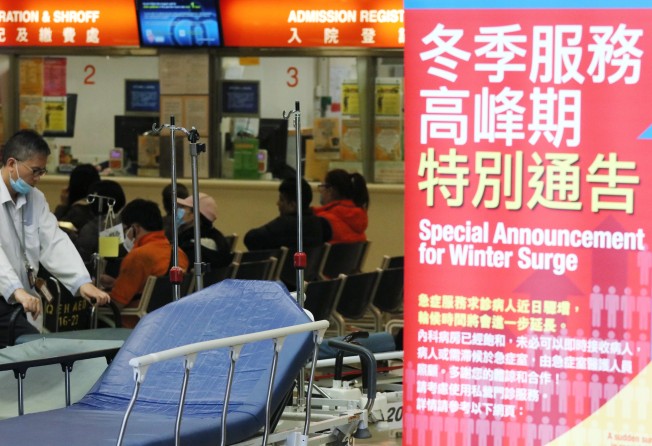Hong Kong flu season already more virulent than last year, with nine more deaths in the space of three days
- The fatalities bring to 16 the number of deaths this year so far, up from seven last year. The total number of cases is 47, five of whom are minors
- Authorities have asked people with non-urgent ailments to seek alternative health care services, as emergency wards are stretched to breaking point

Winter flu in Hong Kong appeared to be more deadly than last year, having claimed nine more lives in the space of three days, pushing up the death toll to 16 this year.
Four more children with influenza were reported to be suffering from serious symptoms as of Sunday, alongside a total of 42 adult cases requiring intensive care since the start of the winter flu season.
The toll was much higher than last year when there were only 19 serious cases reported in the first week of 2018, of whom seven died.
Public hospitals have been stretched to breaking point with an average occupancy rate of medical wards at 115 per cent on Sunday – the highest so far this year, meaning extra temporary beds had to be laid along corridors or in between beds.
Tseung Kwan O Hospital even saw an occupancy rate of 133 per cent, with the most congested wards among all clinics.
At public accident and emergency units, non-urgent patients complained of waits of over eight hours in some of the busiest hospitals, including United Christian Hospital in Kowloon East and North District Hospital in the New Territories. The Hospital Authority said some 5,910 people had flooded the A&E units of public hospitals on Sunday.
“Patients with minor ailments are encouraged to seek alternative health care services, especially during demand surge periods,” said a spokesman for the Hospital Authority.
He said the emergency department has a primary role to take care of patients requiring urgent care. Patients who are critically ill or seriously injured will be given priority in accordance with established triage guidelines, he said.

Latest figures released by the Department of Health showed that there were 42 severe cases of influenza reported in adults, 16 of them resulting in fatalities during this flu season, which began on December 30.
Thirteen of those were elderly patients aged 65 years or older, while another three were aged between 50 and 64.
A total of five patients under the age of 18 have been reported to be in a severe condition this year after four new cases were reported in the last three days.
No fatal case has been recorded so far, whereas a total of three children died of serious flu-related complications in 2018, according to the department.
Announcing Hong Kong has entered the winter influenza season on January 2, the department also warned virus activity could further increase in the coming weeks, and remain at an elevated level for some time.
“We again urge the public, particularly children, the elderly and chronic disease patients, to get vaccinated as early as possible and observe strict personal, hand and environmental hygiene at all times,” said a spokesman.
Tim Pang, spokesman for the Patients’ Rights Association, urged the government to seek more help from private hospitals to help ease the overcrowding at A&E units at public hospitals. “Flu peak season comes every year. It is not something new. The government should have planned well in advance the deployment of staff or other resources to deal with it,” said Pang. “The Hospital Authority could cooperate with private hospitals to take care of less severe cases at A&E units.”